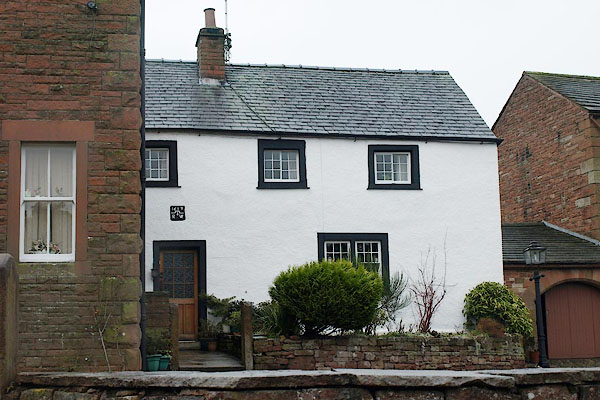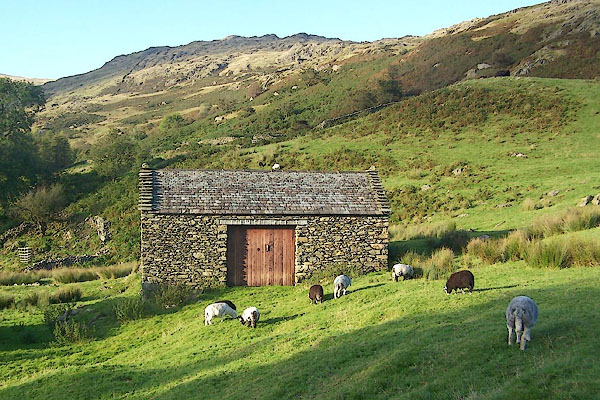




 workplaces, Cumbria
workplaces, Cumbria building features, Cumbria
building features, Cumbria
BSB84.jpg

BRK55.jpg A barn restored / rebuilt recently by a local craftsman.
(taken 9.9.2009)
 goto source
goto sourcePage xx:- "..."
"... I cannot, however, pass over the method of building each particular house, especially as it is somewhat singular, and begins of late to be disused. From the front-door an entry runs close behind the fire-place of the better kitchen, directly across the building, to the back-door, which opens into a yard where the byres and stables generally are. On one side of this entry is the door leading into the down-house or kitchen, where they brew, bake, &c; on the other side of the entry is the passage into the house itself, for so the better kitchen is called; but this passage is close to the back-door, so that before you arrive at the fire you have almost gone round it. The various parts and doors of this entrance into the house are known by the names of Hallen, Heck, and Mill-doors, or the Space between the doors. Opposite to the fire-place is the door of the chamber, or, as it is called in its genuine English name, of the Bower, where the master and mistress of the family sleep. the word Parlour is encroaching fast upon its ancient names: its bed is, in the better sort of houses in these times, placed up stairs, or upon the loft, to use the general and ancient expression: the down-house is become the back-kitchen; the old name of Ambry, for a pantry, is almost lost; and the sconce, long-settle and hemmil, are superceded by more modern furniture. These are a few of the changes which have been introduced of late days into the custom of building houses in Cumberland and the neighbouring parts with a few years past; and though I am willing to believe that modern fashions may have given more elegance to buildings, yet I am far from thinking that they have provided better in general for excluding either the wintry winds, or the heats of Summer. This objection, however, to modern improvements, will not hold in the comparison of the old chimneys with those that are now used: the bak, the randle-tree, the black-hood, and the stoothing, have little to boast of, but their superior utility in drying winter provisions. A circumstance of diminished consequence in these times, on account of the more general resort to markets, and the augmentation of rural commerce."
"I know not that it is worth while noticing the following circumstances; but I never see one of the most antiquated sort of houses that are found in the neighbourhood of those lakes, without imagining a resemblance between them and the houses of some nation, (and particularly of the Greeks,) in remote ages, if one can form an adequate"
 goto source
goto sourcePage xxi:- "idea of them at so great a distance of time. The porch before the house is still to be seen; the threshold, (or freshwood, for it is part of a wooden frame that contains the door,) hath still a degree of sanctity belonging to it, and certain charms are still remembered which had their effect only in that place. The Προδομον and Σπιριν correspond very well with the Mill-doors and Hallen, and also by their covering the entrance into the house, afford a good explanation of the word vestibulum, the derivation of which has been so perplexing to grammarians. The Bower still preserves the meaning and use of the Penetrale, Τοο Σνδουζον in which the principal persons of the family slept; and the internal door of the entry formed of wicker-work is a sort of relic of that art of weaving twigs and osiers of which frequent mention occurs in various authors: the old-fashioned furniture also, with its embossed figures and letters, reminds one of the ancient mode of carrying goblets and other vessels, as mentioned in various authors, but particularly in Theocritus. I am well aware that such resemblances as these may be thought fanciful, and that it will be much more natural, if such resemblances exist, to try to find them among our Northern ancestors: to this sentence I entirely accede; yet where such resemblances can be detected, they serve to prove that similar customs have diffused themselves amongst a vast variety of mortals, and by means with which we are little acquainted; yet such, as whenever they occur, must afford employment to the curious."
"There are several other resemblances between the household-furniture which remains still in these parts, and that of which we read in the classical authors. The method of fastening a door by means of a string and sliding latch, or by a beam laid across on the inside, are still in vogue here, and they may be found in Homer: bright studs in chairs of the better sort are still used as they were among the Greeks. It has been a very old custom to blow the fire by means of a long tube, and seems to have been that to which Juvenal refers, when he says, "Bucca foculum excitat:" this custom is still alive, even since the general introduction of bellows, and may be seen in some of the poorer, and more solitary districts of the North of England. Within these last 50 years, the master of a house, in some places, served his guests perhaps in a ruder stile, but much in the same manner as that in which Alcinous did; and the fork is only a modern substitute for the ancient use of the fingers."
"..."
Brunskill, R W: 1974: Vernacular Architecture of the Lake Counties: Faber and Faber (London):: ISBN 0 571 09459 7
Denyer, Susan: 1991: Traditional Building and Life in the Lake District: Gollancz, Victor (London) &National Trust:: ISBN 0 575 04552 3
Rollinson, William: 1974: Life and Tradition in the Lake District: Dent, J M and sons (London):: ISBN 0 460 07847 X
Taylor, Michael Waistell: 1892: Old Manorial Halls of Westmorland and Cumberland: Wilson, Titus (Kendal, Westmorland) &Thurnam, Charles and Son (Carlisle, Cumberland)
Alcock, N W: 1986: Old Title Deeds: Phillimore and Co (Chichester, Sussex):: ISBN 0 85033 593 0
Amery, Colin:: Period Houses and Their Details: Architectural Press
Armstrong, J R: 1979: Traditional Buildings Accessible to the Public
Artley, Alexandra (ed): 1982: Putting Back the Style: Evans Bros:: ISBN 0 237 45603 6; authentic renovation, interior and exterior
Ayres, James: 1981: Shell Book of the Home in Britain, The: Faber and faber:: ISBN 0 571 11625 6; bibliography
Bailey, John:: Timber Frame Buildings: (from Miss M L Miller, 27 Langdale Rd, Dunstable, Beds)
Barley, M W:: English Farmhouse and Cottage, The: Routledge and Kegan Paul
Brown, Hugh:: Short History of English Architecture, A: Faber
Brown, R J:: English Country Cottage
Brunskill, R W:: Illustrated Handbook of Vernacular Architecture: Faber
Brunskill, R W &Clifton-Taylor, Alec: 1977: English Brickwork: Ward Lock:: ISBN 0 7063 5087 1
Clifton-Taylor, Alec:: Pattern of English Building, The: Faber
Davey, Norman: 1961: History of Building Materials, A: Phoenix House
Dunbar, J G: 1966: Architecture of Scotland, The: Batsford:: ISBN 0 7134 1142 2
Fenton, Alexander &Walker, Bruce:: Rural Architecture of Scotland, The: John Donald (Edinburgh):: ISBN 0 85976 020 0
Fletcher, Valentine:: Chimney Pots and Stacks: Centaur
Harris, John: 1960: English Decorative Ironwork 1610-1836: Alec Tiranti Ltd
Harris, John &Lever, Jill:: Illustrated Glossary of Architecture 850-1830: Faber
Harris, Richard: 1978: Discovering Timber-Framed Buildings: Shire:: ISBN 0 85263 481 1
Harrison, Barry &Hutton, Barbara:: Vernacular Houses in North Yorkshire and Cleveland: John Donald (Edinburgh):: ISBN 0 85976 091 X
Harvey, N: 1970: History of Farm Buildings in England and Wales: David and Charles
Hoskins, W G: 1970: History from the Farm
Iredale, David:: Discovering Your Old House: Shire
Lindley, Kenneth: 1969: Chapels and Meeting Houses: John Baker (London)
Lowrie, J: 1970: House and Garden Book of Cottages: Collins:: ISBN 0 004 35081 2
Major, J K:: Fieldwork in Industrial Archaeology: Batsford
Mercer, E:: Englmsh Vernacular Houses
Naismith, Robert J: 1985: Buildings of the Scottish Countryside: Gollancz:: ISBN 0 575 03383 5
Owen, Michael:: Antique Cast Iron: Blandford
Penayre, John &Penayre, June:: Houses in the Landscape
Pevsner:: Buildings: Penguin
Pride, Glen L: 1996: Dictionary of Scottish Building: Rutland Press &Historic Scotland:: ISBN 1873190 45 X
Prizeman, John: 9935: Your House, the Outside View: Hutchinson:: ISBN 0 09 122380 6
Shore, B C G: 1957: Stones of Britain: Leonard Hill Books
Smith, J T &Yates, E M: 1968: On the Dating of English Houses
West, Trudy:: Timber Frame Houses in England
Woodforde, John: 1969: Truth about Cottages, The: Routledge and Kegan Paul
